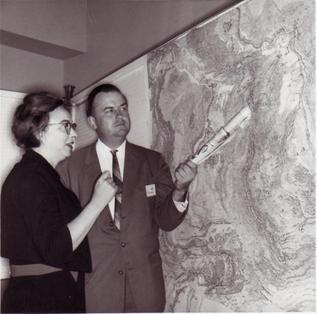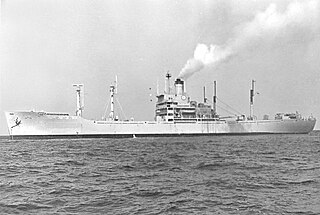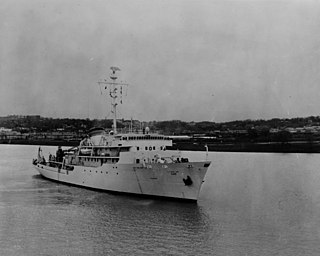
Bruce Charles Heezen was an American geologist. He worked with oceanographic cartographer Marie Tharp at Columbia University to map the Mid-Atlantic Ridge in the 1950s.

The Victory ship was a class of cargo ship produced in large numbers by American shipyards during World War II to replace losses caused by German submarines. They were a more modern design compared to the earlier Liberty ship, were slightly larger and had more powerful steam turbine engines, giving higher speed to allow participation in high-speed convoys and make them more difficult targets for German U-boats. A total of 531 Victory ships were built in between 1944 and 1946.

The Military Sealift Command (MSC) is an organization that controls the replenishment and military transport ships of the United States Navy. Military Sealift Command has the responsibility for providing sealift and ocean transportation for all US military services as well as for other government agencies. It first came into existence on 9 July 1949 when the Military Sea Transportation Service (MSTS) became solely responsible for the Department of Defense's ocean transport needs. The MSTS was renamed the Military Sealift Command in 1970.

The Eltanin Antenna is an object photographed on the sea floor by the Antarctic oceanographic research ship USNS Eltanin in 1964, while photographing the sea bottom west of Cape Horn.

Marie Tharp was an American geologist and oceanographic cartographer. In the 1950s, she collaborated with geologist Bruce Heezen to produce the first scientific map of the Atlantic Ocean floor. Her cartography revealed a more detailed topography and multi-dimensional geographical landscape of the ocean bottom.
A joint support ship (JSS) is a multi-role naval vessel capable of launching and supporting joint amphibious and airlift operations. It can also provide command and control, sealift and seabasing, underway replenishment, disaster relief and logistics capabilities for combined land and sea operations.
The Naval Oceanographic Office (NAVOCEANO), located at John C. Stennis Space Center in south Mississippi, is an echelon IV component of the Naval Meteorology and Oceanography Command (NMOC) and comprises approximately 1,000 civilian, military and contract personnel responsible for providing oceanographic products and services to all elements within the Department of Defense.

USNS Dutton (T-AGS-22) was an oceanographic survey ship for the United States Navy from the late 1950s through the 1980s. She was launched as SS Tuskegee Victory in 1945, Maritime Commission hull number MCV 682, a type VC2-S-AP3 Victory ship. In her U.S. Navy service, she was named after Captain Benjamin Dutton, Jr., and was the second U.S. Navy ship named in his honor.

The Pathfinder-class survey ships are owned by the United States Navy and operated by Military Sealift Command for the Naval Oceanographic Office ("NAVOCEANO"). They have mostly civilian crews, including scientists from NAVOCEANO.

USNS Bowditch is a Pathfinder-class survey ship. She is the third ship in the class. Bowditch is a part of a 29 ship Special Mission Ship program and operates in the South China Sea. She is named after mathematician Nathaniel Bowditch.

USNS Henson (T-AGS-63) is a Pathfinder-class oceanographic survey ship. It is the fourth ship in the class. Henson is named after Matthew Henson, who accompanied Robert Peary, most famously on an expedition intended to reach the Geographic North Pole in 1909.

USNS Bowditch (T-AGS-21) was the lead ship of her class of oceanographic survey ships for the United States Navy. Launched as the SS South Bend Victory in 1945, Maritime Commission hull number MCV 694, a type VC2-S-AP3 Victory ship, she was named for Nathaniel Bowditch, the second U.S. Navy vessel named in his honor. The ship was acquired by the Navy in August 1957 and converted to an AGS at Charleston Naval Shipyard. Named Bowditch on 8 August 1957 and placed in service 8 October 1958 for operation by the Military Sea Transportation Service (MSTS).

RV Atlantis was a ketch rigged research vessel operated by the Woods Hole Oceanographic Institution from 1931 to 1966. The Government of Argentina's National Scientific and Technical Research Council acquired her in 1966 and renamed her El Austral, transferring her to the Argentine Naval Prefecture in 1996 as the training and survey ship PNA Dr. Bernardo Houssay (MOV-1). In 2005 it was decided that a replacement vessel, with modern capablities and equipment was required and a new ship was built in Argentina, with a hull and rig along similar lines, and incorporating some small parts of the original. She was completed in 2009 and put into full service in 2011, again as Dr. Bernardo Houssay.

USNS Soderman (T-AKR-317) is a Large, Medium-Speed Roll-on/Roll-off Ship (LMSR) and is part of the Military Sealift Command. The USNS Soderman is in the Preposition Program which stations ships across the world with military equipment. The Soderman is Watson-class vehicle cargo ship built by National Steel and Shipbuilding Company. The ship was launched on April 26, 2002 and put into service on the 24 of September 2002. The ship was named after Private First Class William A. Soderman, a Medal of Honor Recipient for World War II.

The Spearhead-class expeditionary fast transport (EPF) is a United States Navy–led shipbuilding program to provide a high-speed, shallow draft vessel intended for rapid intra-theater transport of medium-sized cargo payloads. The EPFs can reach speeds of 35–45 knots, and allow the rapid transit and deployment of conventional or special forces, equipment and supplies.

USNS Fall River (JHSV-4/T-EPF-4) is the fourth Spearhead-class expeditionary fast transport, which is operated by the United States Navy's Military Sealift Command (MSC). Fall River was built by Austal USA in Mobile, Alabama.

USNS Kane (T-AGS-27) was a Silas Bent-class survey ship acquired by the United States Navy and delivered to Military Sealift Command in 1967. Kane spent her career performing oceanographic surveys. The ship was equipped with the Oceanographic Data Acquisition System (ODAS) as were oceanographic survey ships USNS Silas Bent (T-AGS-26) and USNS Wilkes (T-AGS-33).

USNS Harvey Milk (T-AO-206) is the second of the John Lewis-class of underway replenishment oilers, operated by the Military Sealift Command (MSC) to support ships of the United States Navy.















